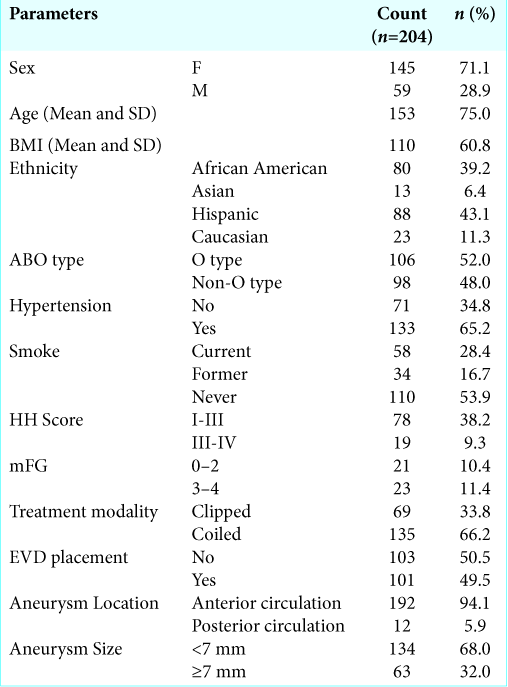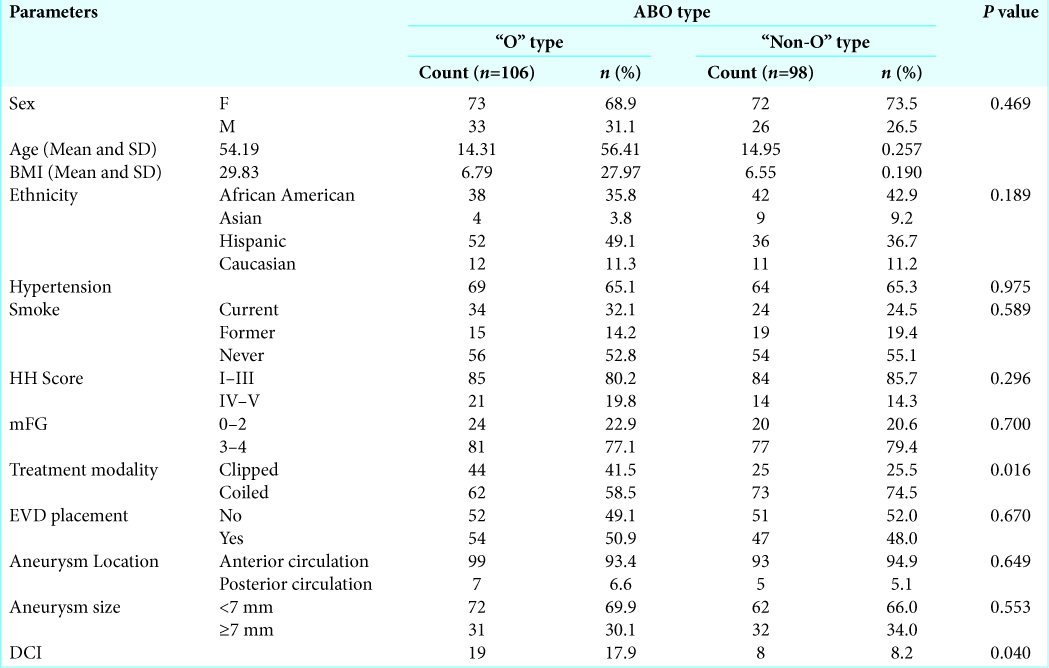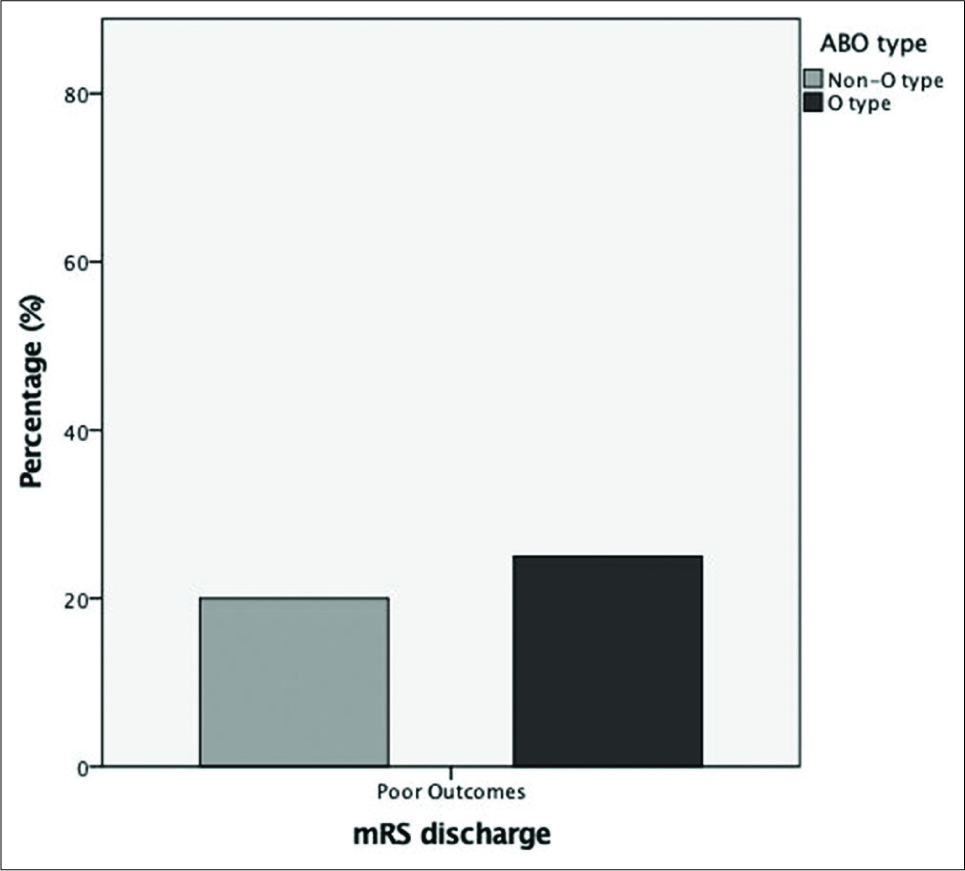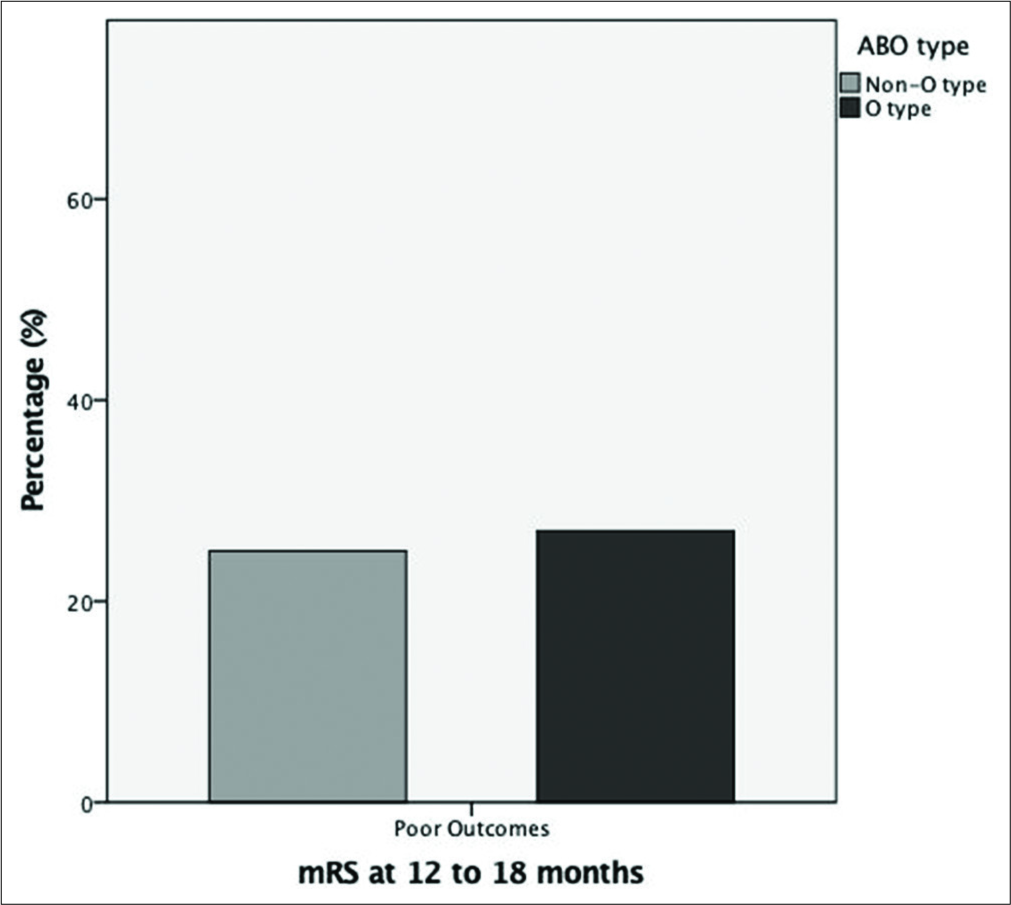- Departments of Neurological Surgery, Weill Cornell, Bronx, New York, United States.
- Department of Neurosurgery, Montefiore Medical Center, Bronx, New York, United States.
Correspondence Address:
David J. Altschul
Department of Neurosurgery, Montefiore Medical Center, Bronx, New York, United States.
DOI:10.25259/SNI_10_2020
Copyright: © 2020 Surgical Neurology International This is an open-access article distributed under the terms of the Creative Commons Attribution-Non Commercial-Share Alike 4.0 License, which allows others to remix, tweak, and build upon the work non-commercially, as long as the author is credited and the new creations are licensed under the identical terms.How to cite this article: Santiago René Unda, Tarini Vats, Rafael De la Garza Ramos, Phillip Cezaryirli, David J. Altschul. Role of ABO blood type in delayed cerebral ischemia onset and clinical outcomes after aneurysmal subarachnoid hemorrhage in an ethnic minority urban population. 16-May-2020;11:108
How to cite this URL: Santiago René Unda, Tarini Vats, Rafael De la Garza Ramos, Phillip Cezaryirli, David J. Altschul. Role of ABO blood type in delayed cerebral ischemia onset and clinical outcomes after aneurysmal subarachnoid hemorrhage in an ethnic minority urban population. 16-May-2020;11:108. Available from: https://surgicalneurologyint.com/surgicalint-articles/10049/
Abstract
Background: In recent years, the role of ABO blood type moved into focus through the discovery of different hemostaseologic properties with importance in many diseases including subarachnoid hemorrhage (SAH). However, the role of ABO blood type in delayed cerebral ischemia (DCI) onset, clinical progress, and outcome after SAH is to date largely unexplored. Our aim was to explore the role of ABO blood group in DCI and clinical outcomes after aneurysmal SAH (aSAH).
Methods: A retrospective analysis was made with data collected from patients who presented aSAH at our single- academic center from 2015 to 2018. We included demographic, clinical, and imaging variables in the univariate analysis and in the subsequent multivariate analysis.
Results: A total of 204 patients were included in this study. About 17.9% of “O” type patients developed a DCI while DCI was reported in only 8.2% of non-O type patients (P = 0.04). “O” type was an independent risk after in the logistic regression after adjusting for significant factors in the univariate analysis (OR=2.530, 95% CI: 1.040- 6.151, P = 0.41). Compared to “non-O” type patients, “O” type patients had a trend to have poorer outcomes at discharge (25.5% vs. 21.3%, P = 0.489) and at 12–18 months (21.1% vs. 19.5%, P = 0.795). However, there were no significant differences.
Conclusion: Our study evidenced that patients with “O” blood type have higher risk of DCI onset after aSAH. Although these findings need to be confirmed, they may aid to improve DCI prevention and outcome predictions.
Keywords: ABO blood type, Aneurysm, Delayed cerebral ischemia, Subarachnoid hemorrhage
INTRODUCTION
Subarachnoid hemorrhage (SAH) caused by aneurysmal rupture (aSAH) is a devastating condition causing the 2–5% of all new strokes[
Recently, ABO blood type has been related with hemorrhagic pathologies, because plasma vWF levels are 25–35% lower in subjects with type O blood group than in individuals without type O blood group and that has been established as the cause of excessive bleeding.[
In this context, ABO blood type linkage with SAH outcomes is possible. However, only few studies had assessed the relation of clinical status at admission and DCI after SAH with blood types but, any of these studies had found a significant influence of ABO blood type.[
MATERIALS AND METHODS
Study design
A retrospective analysis was made with data collected from patients who presented aSAH at a single academic center located in the Bronx, New York, between 2016 and 2018. Institutional review board approved the protocol before study initiation. Informed consent was waived due to the nature of the research.
The principal inclusion criteria were patients over 18 years of age with aSAH. Exclusion criteria comprised nonaneurysmal etiology, patients with incomplete follow-up, and patients with infectious aneurysms.
Examined data
ABO type was classified between “O” type and “non-O” type. Patient socio-demographics (sex, age, ethnicity, BMI, hypertension, and smoke status), procedure-related factors (microsurgical clipping, coiling, and EVD placement), aneurysms characteristics (location in anterior or posterior circulation and size <7 mm or 37 mm), and clinical variables (Hunt Hess Score, mFG, DCI, and modified Rankin Scale (mRS) at discharge and at outpatient follow-up between 12 and 18 months) were included.
After SAH diagnosis, four-vessel 3D angiography was performed in every patient. Selection of patients that underwent microsurgical clipping or coiling was done by the neurointerventional team of our institution that performs both procedures. TCDs were done for 15 days after the SAH routinely every 24 h and cerebral angiography for confirmation of clinically suspected vasospasm during the hospital stay.
All patients had a clinical and neurological examination by the neurovascular team at 24 h’ postprocedure, at discharge, and at 6 mo to 18 mo after treatment. mRS score was recorded in every follow-up by the physician in charge of the case.
Outcome data
The main outcome measure was development of DCI. Secondary outcomes included clinical functional outcomes at discharge and at 12–18 months with the mRS score. For this purpose, we used the following definitions: (1) DCI, the occurrence of focal neurological impairment that lasted more than 1 h (such as hemiparesis, aphasia, apraxia, hemianopia, or neglect), or a decrease of at least two points on the Glasgow Coma Scale (either on the total score or on one of its individual components [eye, motor on either side, and verbal]) and cannot be attributed to other cause[
The aim of this study was (1) to determine the role of ABO blood type in the development of DCI, and (2) to explore the association between ABO blood type with: (a) demographic characteristics, (b) clinical presentation with Hunt-Hess (HH) score at admission, (c) imaging severity with mFG, (d) DCI, and (e) clinical outcomes assessed with mRS.
Statistical analysis
SPSS v.24 software was used to perform the statistical analysis. In regard to demographic, treatment and clinical variables, comparisons of the distributions were made by the Chi-square test) or Student’s t-test as appropriate. Factors with P < 0.10 were included in a multiple logistic regression model to identify independent predictors of outcome. Odds ratios (OR) and 95% confidence intervals (CI) were calculated. P < 0.05 was considered as statistically significant.
RESULTS
A total of 204 patients met the inclusion criteria for this study. The baseline characteristics of the population are summarized in
Compared to “non-O” type patients, “O” type patients had a trend to have poorer outcomes at discharge (25.5% vs. 21.3%, P = 0.489) and at 12–18 months (21.1% vs. 19.5%, P = 0.795). However, there were no significant differences [
DISCUSSION
Our study explored the role of ABO blood type in DCI onset and clinical functional outcomes. The significant finding of this study is the association between “O” blood type and DCI onset. Unlike other studies that have not found any ABO blood type to be related to DCI,[
The increased prevalence of DCI in “O” type patients can be supported in recent evidence that showed lower levels of vWF and VIII factor in plasma lead to excessive bleeding in the subarachnoid space. Although some studies have shown that peripheral vasospasm is related to increase levels of VIII factor,[
We showed that there was no difference between “O” type and “non-O” type groups in the mFG at admission, similar to recent reports,[
The blood type is currently not assessed in the clinical setting to predict any kind of outcomes in SAH patients; however, our work provides evidence that the major complication after SAH, DCI is influenced by the blood type; therefore, patients with “O” blood type may need closer monitoring of vasospasm. Further studies that propose mechanisms by which cerebrovascular tone might be influenced by blood type in SAH conditions are needed to validate these results.
Although, short- and long-term clinical outcomes were not statistically significant between ABO blood types, the “O” type group had higher rates of poor clinical outcomes. These results could be explained by the fact that clinical outcomes are influenced by clinical, socio-economic, demographic, and many other factors, therefore, are expected that the contribution of the ABO blood type is not enough to produce a significant change in the patient’s functional recovery after aSAH.
Limitations
The findings of this study have to be seen in light of some limitations inherent in a single-center retrospective design. Therefore, our study is subject to biases and confounding that may have influenced our study estimates. The sample size was a constraint for the assessment of patients to meet the inclusion and exclusion criteria in this study. The high representation of hispanics and African Americans makes another limitation to translate these findings to the general population. Finally, the relatively small amount of literature makes it difficult to compare the results, we present in this study; therefore, these results should be interpreted with caution for extrapolate or compare with other studies.
CONCLUSIONS
Our study evidenced that patients with “O” blood type have higher risk of DCI onset after aSAH. Although these findings need to be confirmed, they may aid to improve DCI prevention and outcome predictions.
Declaration of patient consent
Patient’s consent not required as patients identity is not disclosed or compromised.
Financial support and sponsorship
Nil.
Conflicts of interest
There are no conflicts of interest.
References
1. Bir SC, Bollam P, Nanda A. Distribution of ABO blood groups in the patients with intracranial aneurysm and association of different risk factors with particular blood type. Asian J Neurosurg. 2015. 10: 153-7
2. De Oliveira Manoel AL, Jaja BN, Germans MR, Yan H, Qian W, Kouzmina E. The VASOGRADE: A simple grading scale for prediction of delayed cerebral ischemia after subarachnoid hemorrhage. Stroke. 2015. 46: 1826-31
3. Dubinski D, Won SY, Behmanesh B, Brawanski N, Geisen C, Seifert V. The clinical relevance of ABO blood type in 100 patients with acute subdural hematoma. PLoS One. 2018. 13: e0204331-
4. Dubinski D, Won SY, Behmanesh B, Kashefiolasi S, Geisen C, Seifert V. Influence of ABO blood type on the outcome after non-aneurysmal subarachnoid hemorrhage. Acta Neurochir. 2018. 160: 761-6
5. Dubinski D, Won SY, Konczalla J, Mersmann J, Geisen C, Herrmann E. The role of ABO blood group in cerebral vasospasm, associated intracranial hemorrhage, and delayed cerebral ischemia in 470 patients with subarachnoid hemorrhage. World Neurosurg. 2017. 97: 532-7
6. Franchini M, Mannucci PM. Von Willebrand factor: Another janus-faced hemostasis protein. Semin Thromb Hemost. 2008. 34: 663-9
7. Frontera JA, Claassen J, Schmidt JM, Wartenberg KE, Temes R, Connolly ES Jr. Prediction of symptomatic vasospasm after subarachnoid hemorrhage: The modified fisher scale. Neurosurgery. 2006. 59: 21-7
8. Frontera JA, Fernandez A, Schmidt JM, Claassen J, Wartenberg KE, Badjatia N. Defining vasospasm after subarachnoid hemorrhage: What is the most clinically relevant definition?. Stroke. 2009. 40: 1963-8
9. Gill JC, Endres-Brooks J, Bauer P, Marks W, Montgomery R. The effect of ABO blood group on the diagnosis of Von Willebrand disease. Blood. 1987. 69: 1691-5
10. Gonzalez NR, Boscardin WJ, Glenn T, Vinuela F, Martin NA. Vasospasm probability index: A combination of transcranial doppler velocities, cerebral blood flow, and clinical risk factors to predict cerebral vasospasm after aneurysmal subarachnoid hemorrhage. J Neurosurg. 2007. 107: 1101-12
11. Jenkins PV, O’Donnell JS. ABO blood group determines plasma Von Willebrand factor levels: A biologic function after all?. Transfusion. 2006. 46: 1836-44
12. Lai PM, Gormley WB, Patel N, Frerichs KU, Aziz-Sultan MA, Du R. Age-dependent radiographic vasospasm and delayed cerebral ischemia in women after aneurysmal subarachnoid hemorrhage. World Neurosurg. 2019. 130: e230-5
13. Le Roux AA, Wallace MC. Outcome and cost of aneurysmal subarachnoid hemorrhage. Neurosurg Clin N Am. 2010. 21: 235-46
14. Liu X, Miller MJ, Joshi MS, Sadowska-Krowicka H, Clark DA, Lancaster JR Jr. Diffusion-limited reaction of free nitric oxide with erythrocytes. J Biol Chem. 1998. 273: 18709-13
15. McGirt MJ, Mavropoulos JC, McGirt LY, Alexander MJ, Friedman AH, Laskowitz DT. Leukocytosis as an independent risk factor for cerebral vasospasm following aneurysmal subarachnoid hemorrhage. J Neurosurg. 2003. 98: 1222-6
16. McKinney JS, Cheng JQ, Rybinnik I, Kostis JB, Myocardial Infarction Data Acquisition System Study Group. Comprehensive stroke centers may be associated with improved survival in hemorrhagic stroke. J Am Heart Assoc. 2015. 4: 1-8
17. Nagahama Y, Allan L, Nakagawa D, Zanaty M, Starke R, Chalouhi N. Dual antiplatelet therapy in aneurysmal subarachnoid hemorrhage: Association with reduced risk of clinical vasospasm and delayed cerebral ischemia. J Neurosurg. 2018. 129: 702-10
18. Taki W, Sakai N, Suzuki H. Determinants of poor outcome after aneurysmal subarachnoid hemorrhage when both clipping and coiling are available: Prospective registry of subarachnoid aneurysms treatment (PRESAT) in Japan. World Neurosurg. 2011. 76: 437-45
19. Tatar Aksoy H, Eras Z, Canpolat FE, Dilmen U. The association between neonatal ABO blood group and intraventricular hemorrhage in extremely low birth weight infants. J Thromb Haemost. 2013. 11: 2074-5
20. Taufique Z, May T, Meyers E, Falo C, Mayer SA, Agarwal S. Predictors of poor quality of life 1 year after subarachnoid hemorrhage. Neurosurgery. 2016. 78: 256-64
21. Vergouwen MD, Vermeulen M, Van Gijn J, Rinkel GJ, Wijdicks EF, Muizelaar JP. Definition of delayed cerebral ischemia after aneurysmal subarachnoid hemorrhage as an outcome event in clinical trials and observational studies: Proposal of a multidisciplinary research group. Stroke. 2010. 41: 2391-5
22. Wu O, Bayoumi N, Vickers MA, Clark P. ABO(H) blood groups and vascular disease: A systematic review and meta-analysis. J Thromb Haemost. 2008. 6: 62-9
23. Zabaneh D, Gaunt TR, Kumari M, Drenos F, Shah S, Berry D. Genetic variants associated with Von Willebrand factor levels in healthy men and women identified using the human CVD beadchip. Ann Hum Genet. 2011. 75: 456-67
24. Zhang H, Mooney CJ, Reilly MP. ABO blood groups and cardiovascular diseases. Int J Vasc Med. 2012. 2012: 1-11










